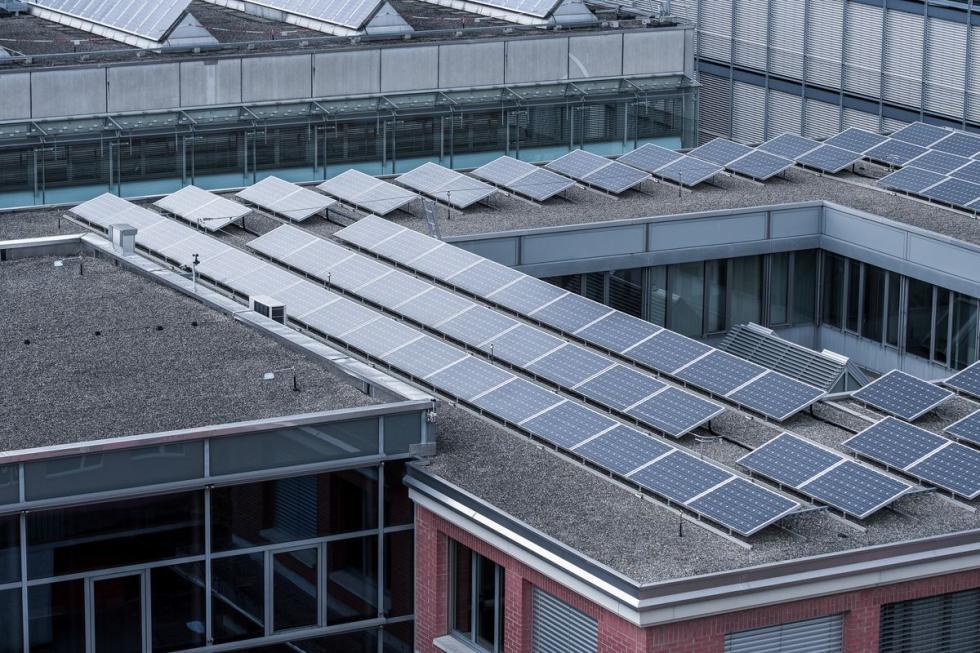Wir sind überzeugt, dass kommende Herausforderungen aus der Energie- und Klimapolitik nur mit einem gemeinsamen Engagement zu meistern sind. Als Nachweis für ein an der Energiestrategie 2050 ausgerichtetes Handeln legen wir unsere ambitionierten Zielwerte bis 2030 in folgenden Bereichen fest: verbesserte Energieeffizienz, Umstellung auf erneuerbare Energien und Steigerung der eigenen ökologischen Stromproduktion, zum Beispiel mit Photovoltaikanlagen.
Mehr Photovoltaik bei der eigenen ökologischen Stromproduktion
Den hundertprozentigen Wechsel von Atomstrom auf erneuerbare Energien haben wir bereits vollzogen. Wir beziehen den kompletten Strom aus zertifizierter Schweizer Wasserkraft sowie aus einem kleinen Teil Solarstrom aus Eigenproduktion der Standorte Bern und Emmen. Mit weiteren Massnahmen im Bereich Effizienzsteigerung, wie z.B. bei der Inbetriebnahme von Maschinen, der Isolation von Gebäuden oder bei der Beleuchtung, beabsichtigen wir eine jährliche Steigerung bis ins Jahr 2030.
Zusätzlich wird in die eigene Stromproduktion investiert. Aus diesem Grund haben wir im Herbst 2020 hat eine Photovoltaik (PV)-Potenzialanalyse über das gesamte Immobilienportfolio gestartet. Analysiert werden der thermische und elektrische Gesamtenergiebedarf, die CO2-Emmissionen und das Potential für PV-Anlagen.
Standorte für neue PV-Anlagen werden derzeit ermittelt. Wir beabsichtigen bis 2026 1'600 MWH/a eigenen Solarstrom zu produzieren. Bis 2030 soll die Solarstromproduktion auf 3'000 MWh/a erhöht werden. Bereits 2021 laufen Planungen, um ausgewählte Gebäude an den RUAG-Standorten Thun, Emmen und Lodrino mit PV-Anlagen auszustatten. Dies umfasst z.B. den Windkanal in Emmen, ein Logistikgebäude in Thun und den Flugzeughangar in Lodrino. Insbesondere der Neubau des Testcenters für Elektromagnetische Verträglichkeit (EMV) als grösste EMV-Infrastruktur der Schweiz ist für dieses Vorhaben vorgesehen.

We’re convinced that the coming challenges from the energy and climate policies can be mastered only with a shared commitment. To prove that our actions are in line with Energy Strategy 2050, we have defined ambitious target values in the following areas by 2030: improved energy efficiency; a switch to renewable energy; and increasing our own sustainable energy production (with photovoltaic systems, for example).
More photovoltaics in our own sustainable energy production
We have already completed the 100% switch from nuclear energy to renewable energy. All power comes from certified Swiss hydropower as well as a small portion of solar power from our own production at the Bern and Emmen sites. With further measures in the area of efficiency enhancement, for example when it comes to putting machines into operation, building insulation or lighting, we intend to achieve enhancement every year through 2030.
We are also investing in our own energy production. For this reason, we started a photovoltaic (PV) potential analysis for our entire real estate portfolio in fall 2020. The total thermal and electrical needs, CO2 emissions and the potential for PV installations are being analyzed.
Sites for new PV installations are currently being determined. We aim to produce 1,600 MWh/a of our own solar power by 2026. The plan is then to increase solar power production to 3,000 MWh/a by 2030. There are already plans in 2021 to equip certain buildings at the RUAG sites in Thun, Emmen and Lodrino with PV installations. This includes, for example, the wind tunnel in Emmen, a logistics building in Thun and the aircraft hangar in Lodrino. In particular, the reconstruction of the test center for electromagnetic compatibility (EMC) as the largest EMC infrastructure in Switzerland is envisaged for this project.
The switch to electric cars
Another important project is the conversion of our own fleet of vehicles to electric cars; RUAG's fleet management has decided on promising fully electric models. In the next three years, RUAG will replace 80% of its pool of vehicles with electric models and build charging stations at all sites. Our site in Emmen will already be getting ten electric charging stations in fall 2021.
Charging stations will also be put into operation in Altdorf, Bern, Stans and Thun this year. By 2023, all RUAG sites in Switzerland will be equipped with a total of around 70 charging stations and 51 electric vehicles will be in operation.

Charging stations at visitor parking lots
For us, sustainability also exists wherever customers and visitors have access, meaning on publicly accessible premises and at visitor parking lots. Charging stations for electric cars have already been put into operation in Thun and Emmen. Bern and Altdorf will be the next sites to be equipped. RUAG currently has two public charging stations per site. The plan is to expand capacities in the public sphere.
Andreas Berger, CEO of RUAG MRO Holding AG, is aware of the relevance of sustainability as a topic and feels confident: “RUAG has joined the ‘Exemplary Energy and Climate’ initiative of the Federal Office of Energy and we know that the topics of climate protection, renewable energy and energy efficiency are important. We will do everything to achieve our goals in the next few years and make our contribution. I am particularly proud of the diversity of the projects we are implementing at RUAG and of course of the commitment of every individual employee in terms of sustainability at work – day after day.”
